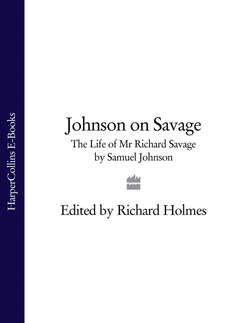Читать книгу Johnson on Savage: The Life of Mr Richard Savage by Samuel Johnson - Samuel Johnson - Страница 6
2
ОглавлениеJohnson heard of Savage’s death in Bristol in August 1743, through their mutual friend Edward Cave, the editor of the Gentleman’s Magazine. It was evidently a great personal blow to him, as he immediately determined to write Savage’s Life. Johnson had in fact already published several short biographical essays with Cave, notably on the piratical sailor Sir Francis Drake (1740), and the Dutch scientist Herman Boerhaave (1739). But this was to be his first attempt at a full length biography on a contemporary subject from original materials. It was also the first to be written con amore. It would eventually run to a book of 180 pages (45,000 words), much longer than any of his subsequent Lives of the Poets.
Within three weeks he announced his intention to defend ‘the unfortunate and ingenious Mr Savage’, in a long letter to the magazine that Cave published in September. The Life would ‘speedily be published by a person who was favoured with his Confidences, and received from himself an Account of most of his Transactions’. This Life would be authentic, and would preserve Savage’s memory from ‘insults and calumnies’. Johnson then made an historic and combative claim about the nature of biography, distinguishing it from romance or fiction.
It may be reasonably imagined that others may have the same Design, but as it is not credible that they can obtain the same Materials, it must be expected they will supply from Invention the want of Intelligence, and that under the Tide of the Life of Savage they will publish only a Novel filled with romantick Adventures, and imaginary Amours. You may therefore perhaps gratify the Lovers of Truth and Wit by giving me leave to inform them in your Magazine, that my Account will be published in 8vo by Mr Roberts of Warwick-Lane.
Johnson had several different kinds of material to draw on. For a start, he had talked a great deal with Savage, and heard his story at length from his own mouth. The accounts of Johnson and Savage walking and talking together all night through the London streets in 1737–8, especially around Westminster and St James’s Square, were eventually to became legendary. This is how Sir John Hawkins remembered them:
Johnson has told me, that whole nights have been spent by him and Savage in conversation of this kind, not under the hospitable roof of a tavern, where warmth might have invigorated their spirits, and wine dispelled their care; but in a perambulation round the squares of Westminster, St James’s in particular, when all the money the could raise was less than sufficient to purchase them the shelter and sordid comforts of a night cellar…
A later friend and biographer, the Irish poet Arthur Murphy, gently embroidered on Johnson’s memories, and moving their location slightly westwards into fashionable Mayfair, gave them an exquisite touch of Dublin absurdity. ‘Johnson has been often heard to relate, that he and Savage walked round Grosvenor Square till four in the morning; in the course of their conversation reforming the world, dethroning princes, establishing new forms of government, and giving laws to the several states of Europe, till fatigued at length with their legislative office, they began to feel the want of refreshment; but could not muster up more than fourpence halfpenny.’
It is therefore particularly interesting that Johnson chooses never to introduce himself explicitly into the Life of Savage. This reticence is unlike, for example, Boswell who appears in propria persona throughout his Life of Johnson (1791); or William Godwin who plays a decisive role in the second half of his Memoirs (1798) of Mary Wollstonecraft. Johnson makes only one passing reference to himself in the third person, at the fateful moment in 1739, when Savage finally leaves London for Wales, never to return. Yet this moment is intensely emotional.
‘Full of these salutary resolutions, [Savage] left London in July 1739, having taken leave, with great tenderness, of his friends, and parted with the author of this narrative with tears in his eyes’, (p.85). Johnson’s sentence seems to leave deliberately ambiguous whether the tears belonged to himself or Savage. Perhaps this was deliberate. But in a marginal note later added to a copy he was correcting in 1748, Johnson wrote: ‘I had then a slight fever’. This surely claims the tears - and the intense emotion - as his own.
Johnson’s personal identification with Savage’s fate is one of the most subtle issues underlying the entire biography. It deeply affects his partial handling of evidence, and wonderfully colours the continuous, shifting ambiguity of its narrative tone. Young Johnson makes common cause with Savage, in his bohemian style of life, his love of late-night talk, his proud sense of being a social outcast, and in his intense political anger at oppression by the rich and powerful. Yet this same self-identification produces strange biographical distortions. How deeply Johnson’s feelings were engaged, and how far objective biography becomes distilled into subjective autobiography, is one of the enduring mysteries of its power, and raises larger questions about the whole genre.
